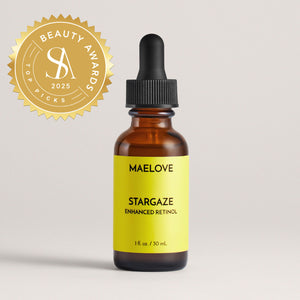Today we address the question, what’s the difference between retinol and retinal (which is short for retinaldehyde)? And which one should I use?
The short answer is, retinaldehyde is a much more effective and stronger retinoid than retinol, by about ten times. If you’re completely new to retinoids then I’d recommend starting out with a product that has retinol in a 0.1% to 0.3% concentration range. After a few months, if your skin feels fine, then step up to retinaldehyde.
Looking for products featuring retinol or retinal?
If you're a beginner, click here for Maelove Stargaze Retinol Serum
If you've already used retinoids before, click here for Maelove Moonlight Retinal Super Serum
So by now you’ve probably heard of retinoids, a family of Vitamin A derivatives, and their amazing skin benefits.
The most famous retinoids in skin-care are retinol spelled with an O, retinaldehyde also known as retinAl, and retinoic acid, also known as tretinoin or Retin-A and available by prescription only.
Out of these 3 retinoids, only retinoic acid has a direct effect on our skin cells. Retinol and Retinaldehyde must be converted into retinoic acid in order to work. How does that conversion happen? Through enzymes.
First, Retinol gets converted into Retinaldehyde. Then Retinaldehyde gets converted into Retinoic Acid.
Retinol is 2 steps removed from Retinoic Acid, while Retinaldehyde is just one step removed. The reason why Retinol is so much weaker than retinaldehyde or retinoic acid is because the conversion that makes Retinol become Retinaldehyde is inefficient. It’s like trying to facetime over a really bad cell signal - not a lot gets through.
However, the conversion step that makes Retinaldehyde into Retinoic Acid is efficient. It’s like facetiming over really good Wifi or 5G. Everything gets through.
Since 1 fewer level of conversion is needed, retinaldehyde is much more powerful than retinol.
But as amazing as retinoids are, they also can cause irritation for some people. Here is where retinaldehyde really shines in that despite its high potency, it’s relatively very gentle. It is almost as powerful as prescription-only tretinoin, but with significantly less irritation. There is a lot of scientific research and evidence behind this that we’ll go into in-depth in our future videos.
And finally, there is an additional bonus attribute that sets Retinaldehyde apart from retinol and retinoic acid. Retinaldehyde can kill acne causing bacteria!
This figure is reproduced from a 1999 study conducted by Pechere and colleagues, in which they found significant reduction in bacterial population when skin is treated with retinaldehyde.
So, if your main goal is treating acne and preventing it from coming back, then I highly recommend retinaldehyde. First, because retinoids in general help treat acne, and second, because retinaldehyde itself is unique among retinoids in that it can kill acne-causing bacteria.
In general, I recommend using retinal over retinol, especially if treating acne is your key objective. But as I say with skincare, it’s better to go slow and steady and then to ramp up. So if you’re completely new to using any type of retinoid product, start with a retinOl and then gradually move onto a retinAl later on.
Click here for Maelove's Deep Guide to Retinoids
This writeup was lead-authored by our senior technical adviser, Sunbin Song, PhD. Sunbin graduated from MIT with a degree in Biology before receiving a doctorate in neuroscience from Georgetown and becoming a research scientist at National Institute of Health.
Sources mentioned:
Pechere M, Pechere JC, Siegenthaler G, Germanier L, Saurat JH (1999). “Antibacterial activity of retinaldehyde against Propionibacterium acnes.” Dermatology. 199(suppl1): 29-31.




